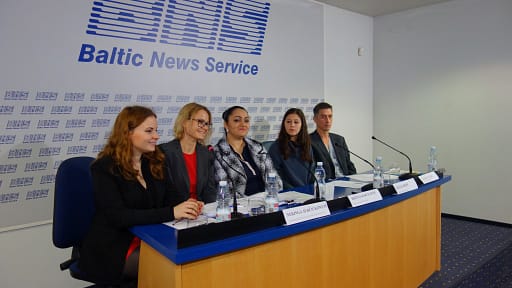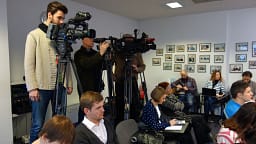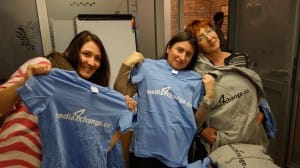On the 17th– 20th of January 2015, last meeting of project “Address of Human Rights – Journalism” took place in Lithuania. International project, better known by the name Media4change, lasted two years and connected partners from Lithuania, Bulgaria, Italy, Spain, Latvia and United Kingdom.
Charlie Hebdo raises new mission for ending project
On the 17th– 20th of January 2015, last meeting of project “Address of Human Rights – Journalism” took place in Lithuania. International project, better known by the name Media4change, lasted two years and connected partners from Lithuania, Bulgaria, Italy, Spain, Latvia and United Kingdom.
The meeting was finished with a result dissemination conference, attracting a major media attention and inducing positive change. “Exactly after the presentation of the research on the image of socially vulnerable groups in media, the journalists started to change their ordinary view and take the ideas from the conference into consideration. Responses as these give hope for further depiction enhancement of socially vulnerable groups.” – said the project manager and the director of the National Institute for Social Integration Neringa Jurčiukonytė.
“From 9/11 to Charlie Hebdo: what power do media created stereotypes hold?” – this final press-conference called all the participants to discuss about how media portrays socially vulnerable groups, in what context they usually appear and how public opinion is formed via image used in the media and other mistakes that are made by media that further the social integration problems. During the press conference the information that was gathered during the project was shared with the journalists by the National Institute of Social Integration director Neringa Jurčiukonytė, representative from Media Diversity Institute in Great Britain Giulia Dessi, Ralph du Long and Roma Integration House director Božena Karvelienė
The event presented the results from Lithuanian media monitoring, which showed that Muslims and Roma people are being depicted in a negative manner or as criminals and the representatives of these two groups are usually left without a voice in the article. “After Charlie Hebdo Muslims are asked opinion on the situation and generally seen in the media, however I am afraid that when situation calms down, Muslims will again be forgotten. Our task is to ensure that ethnic and religion minorities’ opinion would be equally reverberated not only when the situation is dire.” – said UNITED for Intercultural Action and Europe-Russia forum representative Ralph du Long.
Summarising the period of June 1st 2013 and July 31st 2014 we can assert that portrayal of Roma people remained the same – negative and usually used in a criminal context. Roma people remain silent and are never interviewed. The word “gypsy” was used on a regular basis. That shows either the lack of knowledge of the journalists or that members of this group has not been set free from the archetype of being “gypsy”.
The portrayal of Muslim people varies and depends on the situation. If Muslims are discriminated, the journalist usually takes their side, however if group is related with any criminal act like terrorist attack, notions get mixed up and number of news where Muslims are depicted only in a single-sided manner, usually from negative perspective, increases. “In this case Muslims have only one face – the face of a terrorist” – says Neringa Jurčiukonytė.
During the conference, one of the project partners and the representative of MDI G.Dessi presented 5 most commonly made media mistakes relating to the Charlie Hebdo events. First mistake is allowing the usage of graphic images such as the execution of the police officer. Transferring images like that to the public requires taking into account his and his family rights. Second mistake is not giving the full context and dissociating them from news feed directly related to them. Another mistake stems from the interpretation of satire. Media should relinquish the spread of negative and generalizing stereotypes. According to MDI expert Giulia Dessi the biggest mistake in reporting the Charlie Hebdo events was spreading the fear that the whole Europe is in great danger of terrorism. “Usually the media confines to the notion that all Muslims are the same because they believe in one god. In reality there are a lot of cultural and religious differences which are left unseen by the media” says G. Dessi.
The best image has Jewish community, who are quite active in Lithuanian media and has intercession of the government. This determines that media presents most information about them and the message is positive.
During the “Address of Human Rights – Journalism” project partners implemented journalist trainings on the socially vulnerable groups, induced the discussion of editors from all over the Europe and gave hope to an even closer collaboration aspiring for the highest standards of journalism. The good experiences of the project were thoroughly monitored and systemized in methodologies. They will soon reach their target groups and it is expected that it will contribute to more sustainable dissemination of the project results.
And the Media4change movement that stemmed from this project promises to ascend to greater heights and support the journalists in an uneasy task. Although the project is finishing in the end of January, journalists, socially vulnerable group representatives and media and human rights experts are welcomed to register to Media4change community where new challenges await them.





